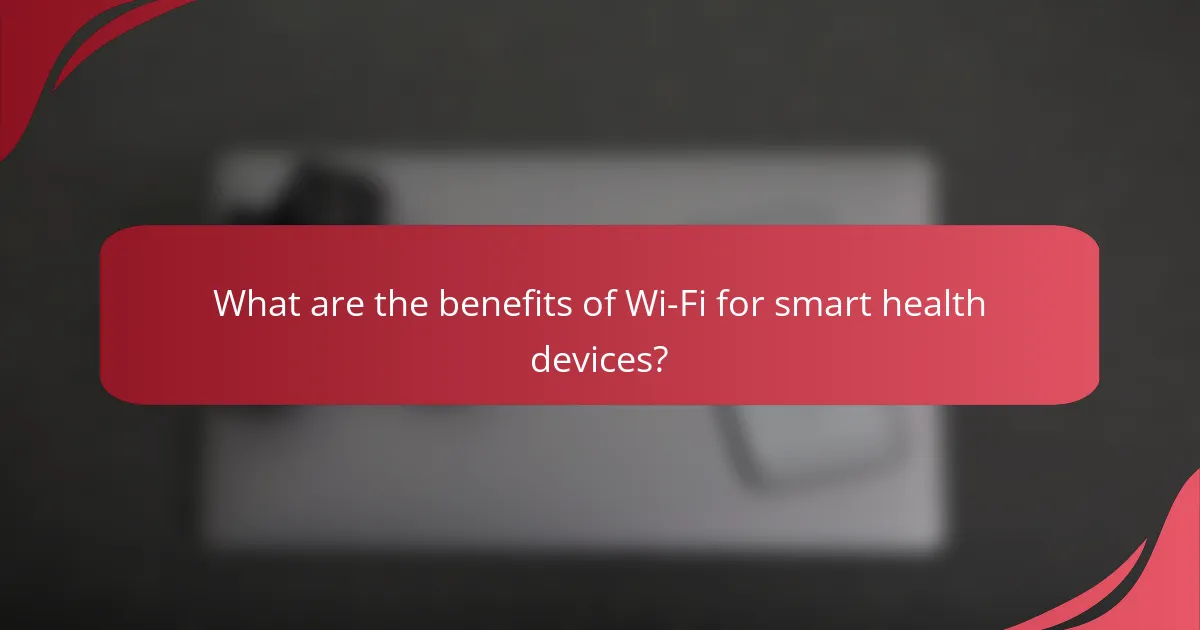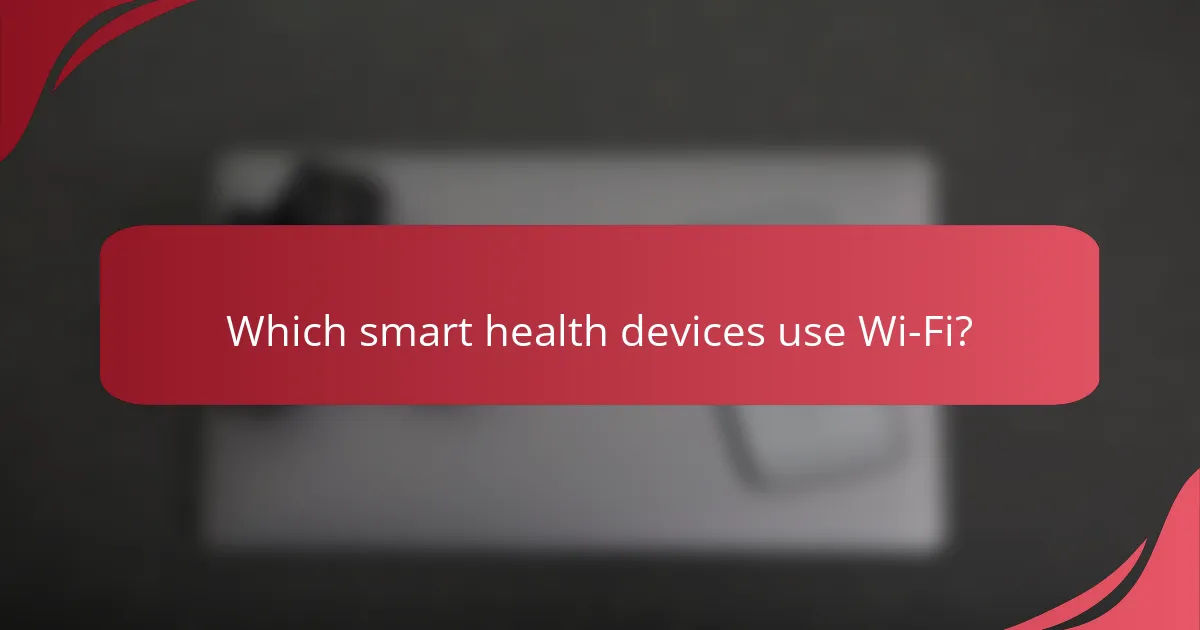Bluetooth and Wi-Fi are essential technologies in the realm of smart health devices, each offering distinct benefits tailored to different applications. While Bluetooth is favored for its energy efficiency and ease of connectivity, Wi-Fi stands out with its high-speed data transfer capabilities, making it suitable for comprehensive health monitoring. Understanding these differences helps in selecting the right technology for specific health device needs.

How do Bluetooth and Wi-Fi compare for smart health devices?
Bluetooth and Wi-Fi serve distinct roles in smart health devices, each with unique advantages. Bluetooth is ideal for low-power applications, while Wi-Fi excels in high-speed data transfer, making the choice dependent on specific device needs.
Bluetooth offers low power consumption
Bluetooth technology is designed for low energy usage, making it suitable for devices that require long battery life, such as fitness trackers and heart rate monitors. This efficiency allows devices to operate for months on a single charge, which is crucial for continuous health monitoring.
Devices using Bluetooth Low Energy (BLE) can maintain connections with minimal power, often consuming less than 1 mW during active communication. This is significantly lower than Wi-Fi, which typically requires more energy for data transmission.
Wi-Fi provides higher data transfer rates
Wi-Fi is capable of much higher data transfer rates compared to Bluetooth, making it suitable for applications that require the transmission of large amounts of data, such as video streaming from health cameras or transferring medical imaging files. Wi-Fi can achieve speeds in the hundreds of Mbps, enabling quick uploads and downloads.
This speed advantage is particularly beneficial in environments where multiple health devices need to share data simultaneously, such as hospitals or clinics. Users should consider Wi-Fi when immediate data access and high bandwidth are priorities.
Bluetooth has a shorter range
Bluetooth typically operates within a range of about 10 to 30 meters, depending on the device class. This limited range is suitable for personal health devices that connect to smartphones or tablets, ensuring close proximity for effective communication.
In contrast, Wi-Fi can cover much larger areas, often extending up to several hundred meters. Therefore, while Bluetooth is ideal for personal use, Wi-Fi is better for applications requiring broader coverage, such as in a home or healthcare facility.
Wi-Fi supports multiple device connections
Wi-Fi networks can support numerous devices simultaneously, making it an excellent choice for environments with multiple smart health devices. This capability allows for seamless integration of various devices, such as smart scales, blood pressure monitors, and health apps, all communicating over the same network.
In contrast, Bluetooth connections are typically limited to one-to-one communication, which can be a drawback in scenarios where multiple devices need to interact. Users should assess their needs for device connectivity when choosing between Bluetooth and Wi-Fi for their health devices.

What are the benefits of Bluetooth for smart health devices?
Bluetooth offers several advantages for smart health devices, including energy efficiency, ease of connectivity, and cost-effectiveness for manufacturers. These benefits make Bluetooth a popular choice for wearable health technology, enhancing user experience while minimizing operational costs.
Energy efficiency for wearable devices
Bluetooth technology is designed to consume minimal power, which is crucial for wearable health devices that rely on batteries. Low Energy Bluetooth (BLE) allows devices to maintain connectivity while using only a fraction of the energy compared to traditional wireless protocols.
This energy efficiency translates to longer battery life, often extending usage to several days or even weeks on a single charge. Users benefit from less frequent charging, making wearables more convenient and reliable for continuous health monitoring.
Simple pairing and connectivity
Bluetooth simplifies the process of connecting smart health devices to smartphones or other systems. Users can typically pair devices with just a few taps, thanks to Bluetooth’s user-friendly interface and automatic discovery features.
This straightforward pairing process enhances user satisfaction and encourages more people to adopt wearable health technology. Additionally, once paired, devices can reconnect automatically, ensuring seamless data transfer without the need for repeated manual setups.
Lower cost for manufacturers
Manufacturers find Bluetooth to be a cost-effective solution for integrating wireless capabilities into health devices. The widespread adoption of Bluetooth technology means that components are readily available and often less expensive than alternatives like Wi-Fi.
This lower cost can lead to more affordable products for consumers, making smart health devices accessible to a broader audience. Additionally, the reduced complexity in design and development can accelerate time-to-market for new health technologies.

What are the benefits of Wi-Fi for smart health devices?
Wi-Fi offers several advantages for smart health devices, primarily through enhanced speed, connectivity, and data management. These benefits enable more efficient health monitoring and integration into users’ daily lives.
Faster data uploads for health monitoring
Wi-Fi provides significantly faster data upload speeds compared to Bluetooth, which is crucial for health monitoring devices that need to transmit large amounts of data quickly. For instance, devices like smart scales or continuous glucose monitors can send readings in real-time, allowing for immediate analysis and feedback.
With upload speeds often reaching several megabits per second, Wi-Fi can handle multiple data streams simultaneously, making it ideal for households with multiple health devices. This capability ensures that users receive timely updates on their health metrics without delays.
Better integration with home networks
Smart health devices that utilize Wi-Fi can seamlessly integrate with existing home networks, allowing for easier management and control through smartphones or tablets. This integration enables users to access their health data from anywhere within the home, enhancing convenience and usability.
Moreover, Wi-Fi-connected devices can often be controlled via smart home systems, enabling automation and alerts. For example, a smart blood pressure monitor can automatically log readings to a central health app, providing a comprehensive view of health trends over time.
Supports real-time health data streaming
Wi-Fi’s high bandwidth allows for real-time streaming of health data, which is essential for applications that require immediate feedback, such as telemedicine consultations. This capability enables healthcare providers to monitor patients’ vital signs live, facilitating timely interventions when necessary.
Additionally, real-time data streaming can enhance user engagement by providing instant insights into health metrics. For example, a fitness tracker can continuously upload heart rate data during workouts, allowing users to adjust their exercise intensity on the fly for optimal performance.

Which smart health devices use Bluetooth?
Many smart health devices utilize Bluetooth technology to facilitate data transfer between the device and smartphones or other health monitoring systems. This wireless communication enables seamless tracking of health metrics, enhancing user experience and convenience.
Fitbit Charge 5
The Fitbit Charge 5 is a popular fitness tracker that employs Bluetooth to sync data with the Fitbit app on smartphones. Users can monitor heart rate, sleep patterns, and activity levels in real-time, making it easier to stay on top of health goals.
One key feature is its built-in GPS, which allows for accurate tracking of outdoor activities without needing a phone. The device also offers notifications for calls and messages, enhancing connectivity while exercising.
Apple Watch Series 8
The Apple Watch Series 8 integrates Bluetooth technology to connect with iPhones, enabling users to receive notifications, track workouts, and monitor health metrics like heart rate and blood oxygen levels. This smartwatch also supports a wide range of health apps, providing comprehensive health insights.
With features like ECG and fall detection, the Apple Watch Series 8 prioritizes user safety. Its seamless integration with the Apple ecosystem allows for easy data sharing and access to health records, making it a versatile tool for health management.
Garmin Venu 2
The Garmin Venu 2 is a fitness smartwatch that uses Bluetooth to sync health data with the Garmin Connect app. It offers advanced health monitoring features, including stress tracking and Body Battery, which helps users manage their energy levels throughout the day.
This device is particularly beneficial for athletes, as it provides detailed performance metrics and training suggestions. The Venu 2 also supports music streaming via Bluetooth, allowing users to enjoy their favorite tunes during workouts without needing their phone.

Which smart health devices use Wi-Fi?
Smart health devices that utilize Wi-Fi typically include those that require constant internet connectivity for data syncing and monitoring. These devices often provide enhanced features such as real-time updates and remote access through applications.
Withings Body+ Smart Scale
The Withings Body+ Smart Scale connects to Wi-Fi to track weight, body fat percentage, and muscle mass, syncing data automatically to the Withings Health Mate app. This enables users to monitor their progress over time and access insights from anywhere.
Consider placing the scale in a location with strong Wi-Fi coverage to ensure consistent data transmission. The scale can recognize multiple users, making it suitable for families or shared living situations.
Amazon Halo Band
The Amazon Halo Band uses Wi-Fi to upload health metrics such as activity levels and sleep patterns to the Halo app. This allows users to receive personalized insights and recommendations based on their health data.
When using the Halo Band, ensure that your Wi-Fi network is secure, as sensitive health information is transmitted. Regularly update the app to access new features and improvements.
Philips Hue Health Monitoring System
The Philips Hue Health Monitoring System leverages Wi-Fi to integrate lighting with health tracking, promoting better sleep and well-being. Users can adjust lighting conditions based on their health data, which can be monitored through the Philips Hue app.
For optimal performance, ensure that your Wi-Fi signal is strong in the areas where the system is used. Familiarize yourself with the app’s settings to customize lighting schedules that align with your health goals.

How to choose between Bluetooth and Wi-Fi for smart health devices?
Choosing between Bluetooth and Wi-Fi for smart health devices depends on factors like range, data transfer speed, and energy consumption. Bluetooth is ideal for short-range, low-energy applications, while Wi-Fi is better for high-speed data transfer over longer distances.
Range and Coverage
Bluetooth typically offers a range of about 10 to 30 meters, making it suitable for personal devices like fitness trackers or smartwatches that connect to smartphones. In contrast, Wi-Fi can cover much larger areas, often exceeding 100 meters indoors, which is beneficial for devices that need to communicate with a central hub or the internet.
Data Transfer Speed
Bluetooth generally has lower data transfer speeds, usually around 1 to 3 Mbps, which is sufficient for transmitting health metrics like heart rate or step count. Wi-Fi, on the other hand, can achieve speeds of 100 Mbps or more, making it suitable for devices that require real-time data streaming, such as video monitoring systems.
Energy Consumption
Bluetooth is designed for low energy consumption, which is crucial for battery-operated health devices that need to last for days or weeks without recharging. Wi-Fi consumes more power, making it less ideal for devices that rely on battery life, unless they are connected to a constant power source.
Security Considerations
Both Bluetooth and Wi-Fi have security protocols, but Wi-Fi generally offers more robust encryption options, which is important for protecting sensitive health data. However, Bluetooth has made significant improvements with its latest versions, providing secure connections for personal health devices.
Use Cases
Bluetooth is commonly used in wearable devices like heart rate monitors and smart scales, where low power and short-range are sufficient. Wi-Fi is often utilized in home health monitoring systems that require constant internet access, such as smart blood pressure monitors that upload data to the cloud for remote monitoring.


